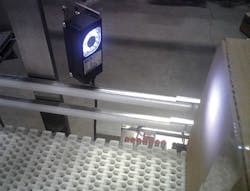A major U.S. food manufacturer called on packaging machinery builder Brenton Engineering (www.brentonengineering.com) to supply secondary packaging equipment for a meat packaging line. This included a case packer, a print-and-apply labeler for ingredients, a print-and-apply labeler for bar codes, a robotic palletizing cell, and all of the necessary conveyor connections between the machines.
To verify accuracy in labeling, Brenton included in the new line two sensor devices from Sick (www.sick.com). The first sensor checks the scannability of a linear bar code that is printed by the first thermal-transfer print-and-apply machine, supplied by ID Technology (www.idtechnology.com). Should there be any defect in the code that makes it difficult to scan, a signal is sent to the PLC to reject that case.
The second sensor in the line, a Sensick CVS2, is mounted on a conveyor just downstream from the second thermal-transfer print-and-apply labeler, also from ID Technology. It’s an optical electronic sensor that checks for the presence of colors. It counts pixels of selected colors in a defined field of view and switches the output as soon as the number of pixels counted exceeds a taught-in threshold.
“It can be programmed on the fly,” says Brenton’s David Setterstrom, senior controls engineer. “That’s one of the reasons we chose it. As new label colors enter the picture at this particular plant, we have the ability to ‘teach’ the sensor these new colors.”
The colors to which Setterstrom refers are the colors used to identify the foodservice chains that receive these cases of meat. It’s a way of keeping, for example, a Wendy’s shipment from going to a Jack-in-the-Box store. Shades of the same color can also be distinguished by the CVS2. So if orange, for example, is the appropriate color for Wendy’s hamburgers and light orange is for Wendy’s chicken, the pixel-counting skills of the CVS2 permit it to distinguish one shade from the other.
Setterstrom also appreciates the CVS2 from an ease of integration standpoint.
“All label formats get downloaded automatically from this customer’s ERP (Enterprise Resource Planning) system to the packaging line,” says Setterstrom. “The download identifies what label rolls to mount and it also brings instructions to the CVS2 so that it knows what color it’s looking for.”
The line might handle cases destined for two or three different customers each shift. That means changeover needs to be handled pretty efficiently, says Setterstrom. The CVS2, he notes, is up to the task.
“I like that an operator can enter at a touch screen the SKU that needs to run and automatically all the data that’s needed at multiple packaging machines in the line, including the CVS2, is transmitted without any need for operator intervention,” says Setterstrom.
An additional attribute of the CVS2, notes Setterstrom, is ease of set-up and training. Overall, he adds, “We looked at a number of options where this application is concerned, and the Sick unit stood out.”
Brenton Engineering
www.brentonengineering.com
Sick
www.sick.com
ID Technology
www.idtechnology.com
About the Author
Pat Reynolds
VP Editor Emeritus

Leaders relevant to this article:
